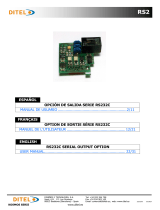
USER’S MANUAL SOFTWARE. SATHUNTER+
Page 2 10/2010
1.2 Software Installation
The installation file of the SATHUNTER+ SOFTWARE is supplied on a memory
drive with the equipment or you can download it from the PROMAX web page
(www.promaxelectronics.com). Before proceeding the installation, read the following
instructions. If in doubt, please contact the technical support.
1. Double click on the file “Setup.exe“.
2. It will start the installation wizard that will guide you during the process.
3. When finishing the installation, it will appear a window in order to install a driver,
which creates a virtual serial USB port on your computer. This driver is required
to use the program. If you have already installed the driver, click on “Exit” to
complete the installation. If you have not installed the driver yet or you are
unsure about that, click on the “Setup USB Driver” button. If the driver is
already installed, the program will warn you.
4. The installation program creates, by default, a directory in the path
”C:\ Program Files \ PROMAX \ SATHUNTER+”, where are copied application
files.
5. To run the program go to: Start \ Programs \ PROMAX \ SATHUNTER+.
6. In the section “2. Software Description” is explained in detail how works the
program.
1.3 Legal conditions
Read the contract carefully in its entirety before you install the program.
Installing the program means that you have accepted the following terms and
conditions.
1. SUBJECT. The subject matter of this Contract is the grant to the end user by
PROMAX ELECTRONICA, S.A. a non-exclusive and non-transferrable
personal license to use this version of the RM-011 CONFIGURATION
SOFTWARE FOR SATHUNTER+ program for an indefinite period of time.
2. LICENCE. The Licence of Use granted hereby refers exclusively to the end
user, who shall be considered legitimised to use the program only.
3. OWNERSHIP OF THE SOFTWARE. The end user acknowledges that the
program referred to in this Contract is the exclusive property of PROMAX
ELECTRONICA, S.A. The end user may only acquire the personal and non-
transferrable right to use the software that is the subject matter of this Contract
for the purposes herein expressed.
Since the program granted is protected by industrial and intellectual copyright,
infringements by the user of these aforementioned obligations will give rise to
the corresponding liabilities in accordance with the legislation in force.




















